 Following is an excerpt from my new book, "Incredible Stories From Space: A Behind-the-Scenes Look at the Missions Changing Our View of the Cosmos," which will be released tomorrow, Dec. 20, 2016. The book is an inside look at several current NASA robotic missions, and this excerpt is part 1 of 3 which will be posted here on Universe Today, of Chapter 2, "Roving Mars with Curiosity." The book is available for order on Amazon and Barnes & Noble. Seven Minutes of Terror
It takes approximately seven minutes for a moderate-sized spacecraft – such as a rover or a robotic lander -- to descend through the atmosphere of Mars and reach the planet's surface. During those short minutes, the spacecraft has to decelerate from its blazing incoming speed of about 13,000 mph to touch down at just 2 mph or less.
This requires a Rube Goldberg-like series of events to take place in perfect sequence, with precise choreography and timing. And it all needs to happen automatically via computer, with no input from anyone on Earth. There is no way to guide the spacecraft remotely from our planet, about 150 million miles (250 million kilometers) away. At that distance, the radio signal delay time from Earth to Mars takes over 13 minutes. Therefore, by the time the seven-minute descent is finished, all those events have happened – or not happened – and no one on Earth knows which. Either your spacecraft sits magnificently on the surface of Mars or lies in a crashed heap.

A depiction of the numerous events required for the Curiosity rover to land successfully on Mars. Credit: NASA/JPL.
That's why scientists and engineers from the missions to Mars call it "Seven Minutes of Terror."
And with the Mars Science Laboratory (MSL) mission, which launched from Earth in November of 2011, the fear and trepidation about what is officially called the 'Entry, Descent and Landing' (EDL) increased exponentially. MSL features a 1-ton, 6-wheeled rover named Curiosity, and this rover was going to use a brand new, untried landing system.
To date, all Mars landers and rovers have used -- in sequence -- a rocket-guided entry, a heat shield to protect and slow the vehicle, then a parachute, followed by thrusters to slow the vehicle even more. Curiosity would use this sequence as well. However, a final, crucial component encompassed one of the most complex landing devices ever flown.
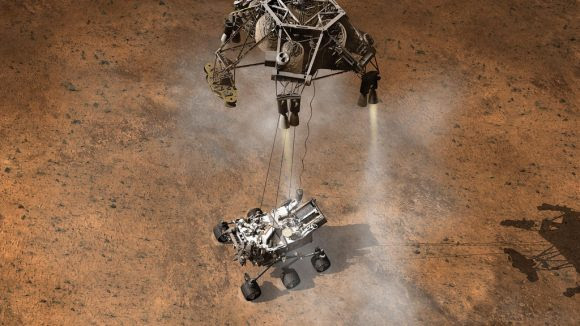
Artists concept of the moment the Curiosity rover touches down on the Martian surface, suspended on a bridle beneath the spacecraft's descent stage. Credit: NASA/JPL-Caltech
Dubbed the "Sky Crane," a hovering rocket stage would lower the rover on 66 ft. (20 meter) cables of Vectran rope like a rappelling mountaineer, with the rover soft-landing directly on its wheels. This all needed to be completed in a matter of seconds, and when the on-board computer sensed touchdown, pyrotechnics would sever the ropes, and the hovering descent stage would zoom away at full throttle to crash-land far from Curiosity.
Complicating matters even further, this rover was going to attempt the most precise off-world landing ever, setting down inside a crater next to a mountain the height of Mt. Rainier.
A major part of the uncertainty was that engineers could never test the entire landing system all together, in sequence. And nothing could simulate the brutal atmospheric conditions and lighter gravity present on Mars except being on Mars itself. Since the real landing would be the first time the full-up Sky Crane would be used, there were questions: What if the cables didn't separate? What if the descent stage kept descending right on top of the rover?
If the Sky Crane didn't work, it would be game-over for a mission that had already overcome so much: technical problems, delays, cost overruns, and the wrath of critics who said this $2.5 billion Mars rover was bleeding money away from the rest of NASA's planetary exploration program.

Mosaic of the Valles Marineris hemisphere of Mars, similar to what one would see from orbital distance of 2500 km. Credit: NASA/JPL-Caltech
Missions to Mars
With its red glow in the nighttime sky, Mars has beckoned skywatchers for centuries. As the closest planet to Earth that offers any potential for future human missions or colonization, it has been of great interest in the age of space exploration. To date, over 40 robotic missions have been launched to the Red Planet …. or more precisely, 40-plus missions have been attempted.
Including all US, European, Soviet/Russian and Japanese efforts, more than half of Mars missions have failed, either because of a launch disaster, a malfunction en route to Mars, a botched attempt to slip into orbit, or a catastrophic landing. While recent missions have had greater success than our first pioneering attempts to explore Mars in situ (on location) space scientists and engineers are only partially kidding when they talk about things like a 'Great Galactic Ghoul' or the 'Mars Curse' messing up the missions.
But there have been wonderful successes, too. Early missions in the 1960's and 70's such as Mariner orbiters and Viking landers showed us a strikingly beautiful, although barren and rocky world, thereby dashing any hopes of 'little green men' as our planetary neighbors. But later missions revealed a dichotomy: magnificent desolation combined with tantalizing hints of past -- or perhaps even present day – water and global activity.
Today, Mars' surface is cold and dry, and its whisper-thin atmosphere doesn't shield the planet from bombardment of radiation from the Sun. But indications are the conditions on Mars weren't always this way. Visible from orbit are channels and intricate valley systems that appear to have been carved by flowing water.
For decades, planetary scientists have debated whether these features formed during brief, wet periods caused by cataclysmic events such as a massive asteroid strike or sudden climate calamity, or if they formed over millions of years when Mars may have been continuously warm and wet. Much of the evidence so far is ambiguous; these features could have formed either way. But billions of years ago, if there were rivers and oceans, just like on Earth, life might have taken hold.
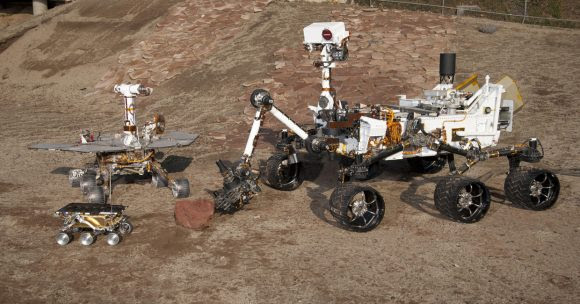
Three Generations of Mars Rovers in the 'Mars Yard' at the Jet Propulsion Laboratory. The Mars Pathfinder Project (front) landed the first Mars rover - Sojourner - in 1997. The Mars Exploration Rover Project (left) landed Spirit and Opportunity on Mars in 2004. The Mars Science Laboratory Curiosity rover landed on Mars in August 2012. Credit: NASA/JPL-Caltech.
The Rovers
The Curiosity rover is the fourth mobile spacecraft NASA has sent to Mars' surface. The first was a 23-pound (10.6 kg) rover named Sojourner that landed on a rock-covered Martian plain on July 4, 1997. About the size of a microwave oven, the 2-foot- (65 cm) long Sojourner never traversed more than 40 feet away from its lander and base station. The rover and lander together constituted the Pathfinder mission, which was expected to last about a week. Instead, it lasted nearly three months and the duo returned 2.6 gigabits of data, snapping more than 16,500 images from the lander and 550 images from the rover, as well as taking chemical measurements of rocks and soil and studying Mars' atmosphere and weather. It identified traces of a warmer, wetter past for Mars.
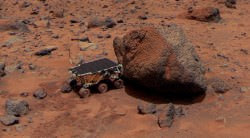
Sojourner - NASA's 1st Mars Rover. Rover takes an Alpha Proton X-ray Spectrometer (APXS) measurement of Yogi rock after Red Planet landing on July 4, 1997 landing. Credit: NASA
The mission took place when the Internet was just gaining popularity, and NASA decided to post pictures from the rover online as soon as they were beamed to Earth. This ended up being one of the biggest events in the young Internet's history, with NASA's website (and mirror sites set up for the high demand) receiving over 430 million hits in the first 20 days after landing.
Pathfinder, too, utilized an unusual landing system. Instead of using thrusters to touch down on the surface, engineers concocted a system of giant airbags to surround and protect the spacecraft. After using the conventional system of a rocket-guided entry, heat shield, parachutes and thrusters, the airbags inflated and the cocooned lander was dropped from 100 feet (30 meters) above the ground. Bouncing several times across Mars' surface times like a giant beach ball, Pathfinder eventually came to a stop, the airbags deflated and the lander opened up to allow the rover to emerge.
While that may sound like a crazy landing strategy, it worked so well that NASA decided to use larger versions of the airbags for the next rover mission: two identical rovers named Spirit and Opportunity. The Mars Exploration Rovers (MER) are about the size of a riding lawn mower, at 5.2 feet (1.6 meters) long, weighing about 400 lbs (185 kilograms). Spirit landed successfully near Mars' equator on January 4, 2004, and three weeks later Opportunity bounced down on the other side of the planet. The goal of MER was to find evidence of past water on Mars, and both rovers hit the jackpot. Among many findings, Opportunity found ancient rock outcrops that were formed in flowing water and Spirit found unusual cauliflower-shaped silica rocks that scientists are still studying, but they may provide clues to potential ancient Martian life.
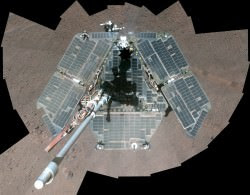
A self-portrait of the Opportunity rover shortly after dust cleared its solar panels in March 2014. Credit: NASA/JPL-Caltech/Cornell Univ./Arizona State Univ.
Incredibly, at this writing (2016) the Opportunity rover is still operating, driving more than a marathon (26 miles/42 km) and it continues to explore Mars at a large crater named Endeavour. Spirit, however, succumbed to a loss of power during the cold Martian winter in 2010 after getting stuck in a sandtrap. The two rovers far outlived their projected 90-day lifetime.
Somehow, the rovers each developed a distinct 'personality' – or, perhaps a better way to phrase it is that people assigned personalities to the robots. Spirit was a problem child and drama queen but had to struggle for every discovery; Opportunity, a privileged younger sister, and star performer, as new findings seemed to come easy for her. Spirit and Opportunity weren't designed to be adorable, but the charming rovers captured the imaginations of children and seasoned space veterans alike. MER project manager John Callas once called the twin rovers "the cutest darn things out in the Solar System." As the long-lived, plucky rovers overcame hazards and perils, they sent postcards from Mars every day. And Earthlings loved them for it.
Curiosity
While it's long been on our space to-do list, we haven't quite yet figured out how to send humans to Mars. We need bigger and more advanced rockets and spacecraft, better technology for things like life support and growing our own food, and we really don't have the ability to land the very large payloads needed to create a human settlement on Mars.
But in the meantime – while we try to figure all that out -- we have sent the robotic equivalent of a human geologist to the Red Planet. The car-sized Curiosity rover is armed with an array of 17 cameras, a drill, a scoop, a hand lens, and even a laser. These tools resemble equipment geologists use to study rocks and minerals on Earth. Additionally, this rover mimics human activity by mountain climbing, eating (figuratively speaking), flexing its (robotic) arm, and taking selfies.

Artist concept of the Curiosity rover, with the various science instruments labeled. Credit: NASA/JPL.
This roving robotic geologist is also a mobile chemistry lab. A total of 10 instruments on the rover help search for organic carbon that might indicate the raw material required by life, and "sniff" the Martian air, trying to smell if gasses like methane — which could be a sign of life — are present. Curiosity's robotic arm carries a Swiss Army knife of gadgets: a magnifying lens-like camera, a spectrometer to measure chemical elements, and a drill to bore inside rocks and feed samples to the laboratories named SAM (Sample Analysis at Mars) and) and CheMin (Chemistry and Mineralogy). The ChemCam laser can vaporize rock from up to 23 feet (7 meters) away, and identify the minerals from the spectrum of light emitted from the blasted rock. A weather station and radiation monitor round out the devices on board.
With these cameras and instruments, the rover becomes the eyes and hands for an international team of about 500 earthbound scientists.
While the previous Mars rovers used solar arrays to gather sunlight for power, Curiosity uses an RTG like New Horizons. The electricity generated from the RTG repeatedly powers rechargeable lithium-ion batteries, and the RTG's heat is also piped into the rover chassis to keep the interior electronics warm.
With Curiosity's size and weight, the airbag landing system used by the previous rovers was out of the question. As NASA engineer Rob Manning explained, "You can't bounce something that big." The Sky Crane is an audacious solution.
Curiosity's mission: figure out how Mars evolved over billions of years and determine if it once was — or even now is — capable of supporting microbial life.
Curiosity's target for exploration: a 3.4 mile (5.5 km) -high Mars mountain scientists call Mt. Sharp (formally known as Aeolis Mons) that sits in the middle of Gale Crater, a 96-mile (155-km) diameter impact basin.
Gale was chosen from 60 candidate sites. Data from orbiting spacecraft determined the mountain has dozens of layers of sedimentary rock, perhaps built over millions of years. These layers could tell the story of Mars' geologic and climate history. Additionally, both the mountain and the crater appear to have channels and other features that look like they were carved by flowing water.
The plan: MSL would land in a lower, flatter part of the crater and carefully work its way upward towards the mountain, studying each layer, essentially taking a tour of the epochs of Mars' geologic history.
The hardest part would be getting there. And the MSL team only had one chance to get it right.
Landing Night
Curiosity's landing on August 5, 2012 was one of the most anticipated space exploration events in recent history. Millions of people watched events unfold online and on TV, with social media feeds buzzing with updates. NASA TV's feed from JPL's mission control was broadcast live on the screens in New York's Time Square and at venues around the world hosting 'landing parties.'
But the epicenter of action was at JPL, where hundreds of engineers, scientists and NASA officials gathered at JPL's Space Flight Operations Facility. The EDL team – all wearing matching light blue polo shirts -- monitored computer consoles at mission control.

MSL project scientist Ashwin Vasavada with a full scale model of the Curiosity rover. Credit: NASA/JPL.
At the time of the landing, Ashwin Vasavada was one of the longest serving scientists on the mission team, having joined MSL as the Deputy Project Scientist in 2004 when the rover was under construction. Back then, a big part of Vasavada's job was working with the instrument teams to finalize the objectives of their instruments, and supervise technical teams to help develop the instruments and integrate them with the rover.
Each of the ten selected instruments brought a team of scientists, so with engineers, additional staff and students, there were hundreds of people getting the rover ready for launch. Vasavada helped coordinate every decision and modification that might affect the eventual science done on Mars. During the landing, however, all he could do was watch.
"I was in the room next door to the control room that was being shown on TV," Vasavada said. "For the landing there was nothing I could do except realize the past eight years of my life and my entire future was all riding on that seven minutes of EDL."
Plus, the fact that no would know the real fate of the rover until 13 minutes after the fact due to the radio delay time led to a feeling of helplessness for everyone at JPL.
"Although I was sitting in a chair," Vasavada added, "I think I was mentally curled up in the fetal position."
As Curiosity sped closer to Mars, three other veteran spacecraft already orbiting the planet moved into position to be able to keep an eye on the newcomer MSL as it transmitted information on its status. At first, MSL communicated directly to the Deep Space Network (DSN) antennas on Earth.
To make telemetry from the spacecraft as streamlined as possible during EDL, Curiosity sent out 128 simple but distinct tones indicating when steps in the landing process were activated. Allen Chen, an engineer in the control room announced each as they came: one sound indicated the spacecraft entered Mars' atmosphere; another signaled the thrusters fired, guiding the spacecraft towards Gale Crater. Tentative clapping and smiles came from the team at Mission Control at the early tones, with emotions increasing as the spacecraft moved closer and closer to the surface.
Partway through the descent, MSL went below the Martian horizon, putting it out of communication with Earth. But the three orbiters -- Mars Odyssey, Mars Reconnaissance Orbiter and Mars Express -- were ready to capture, record and relay data to the DSN.
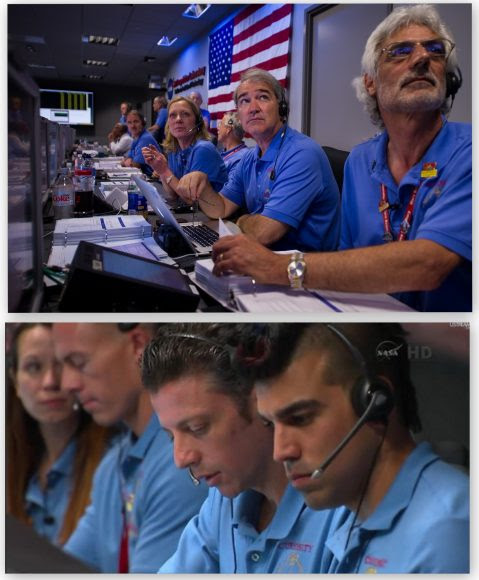
Scenes from landing night for the Curiosity rover at JPL's Space Flight Operations Facility. Credit: NASA/JPL.
Seamlessly, the tones kept coming to Earth as each step of the landing continued flawlessly. The parachute deployed. The heat shield dropped away. A tone signaled the descent stage carrying the rover let go of the parachute, another indicated powered flight and descent toward the surface. Another tone meant the Sky Crane began lowering the rover to the surface.
A tone arrived, indicating Curiosity's wheels touched the surface, but even that didn't mean success. The team had to make sure the Sky Crane flyaway maneuver worked.
Then, came the tone they were waiting for: "Touchdown confirmed," cheered Chen. "We're safe on Mars!"
Pandemonium and joy erupted in JPL's mission control, at the landing party sites, and on social media. It seemed the world celebrated together at that moment. Cost overruns, delays, all the negative things ever said about the MSL mission seemed to vanish with the triumph of landing.
"Welcome to Mars!" the Director of the Jet Propulsion Laboratory, Charles Elachi said at a press conference following the dramatic touchdown, "Tonight we landed, tomorrow we start exploring Mars. Our Curiosity has no limits."
"The seven minutes actually went really fast," said Vasavada. "It was over before we knew it. Then everybody was jumping up and down, even though most of us were still processing that it went so successfully."
That the landing went so well -- indeed perfectly -- may have actually shocked some of the team at JPL. While they had rehearsed Curiosity's landing several times, remarkably, they were never able to land the vehicle in their simulations.
"We tried to rehearse it very accurately," Vasavada said, "so that everything was in synch -- both the telemetry that we had simulated that would be coming from the spacecraft, along with real-time animations that had been created. It was a pretty complex thing, but it never actually worked. So the real, actual landing was the first time everything worked right."
Curiosity was programmed to immediately take pictures of its surroundings. Within two minutes of the landing, the first images were beamed to Earth and popped up on the viewing screens at JPL.
"We had timed the orbiters to fly over during the landing, but didn't know for sure if their relay link would last long enough to get the initial pictures down," Vasavada said. "Those first pictures were fairly ratty because the protective covers were still on the cameras and the thrusters had kicked up a lot of dust on the covers. We couldn't really see it very well but we still jumped up and down nevertheless because these were pictures from Mars."
Amazingly, one of the first pictures showed exactly what the rover had been sent to study.
"We had landed with the cameras basically facing directly at Mt. Sharp," Vasavada said, shaking his head. "In the HazCam (hazard camera) image, right between the wheels, we had this gorgeous shot. There was the mountain. It was like a preview of the whole mission, right in front of us." 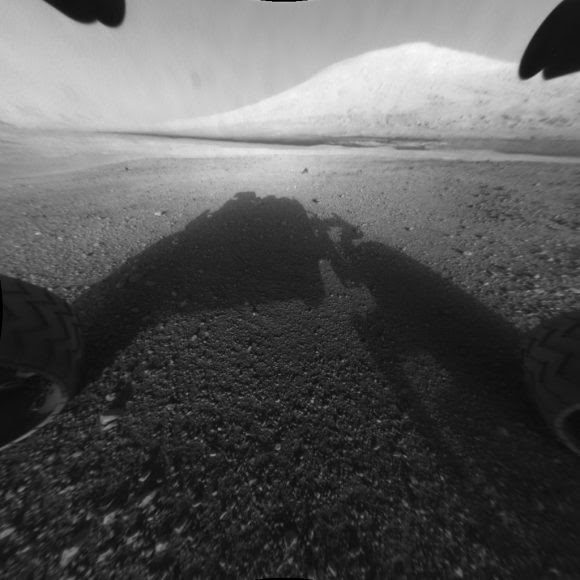
An image captured by the Curiosity rover shortly after it landed on the Red Planet on August 5, 2015, showing the rover's main science target, Mount Sharp. The rover's shadow can be seen in the foreground and the dark band beyond are dunes. Credit; NASA/JPL-Caltech.
Tomorrow: Part 2 of "Roving Mars With Curiosity," with 'Living on Mars Time' and 'Discoveries'
|
Monday, December 19, 2016
Book Excerpt: “Incredible Stories From Space,” Roving Mars With Curiosity, part 1
Subscribe to:
Post Comments (Atom)
ENERGY NEWS
Oil prices rally on geopolitical tensions April 10 (UPI) -- Geopolitical factors spilled over into the broader economic mood early ...
-
SpaceX Postpones Falcon 9 Rocket Launch Resumption to January 2017 Ken Kremer द्वारा SpaceX Falcon 9 Stage 1 arriving in Califo...
-
© Masao et al. / ELife 2016 MOSCOW, December 14 - RIA Novosti . Scientists have found traces in Tanzania unusually l...
-
06-Apr-2017 Honey Bees Have Sharper Eyesight Than We Thought Research conducted at the University of Adelaide has discovered that be...
-
LMRC Recruitment 2017 lmrcl.com Vacancy Latest Notification Apply ALIMCO Recruitment 2017 alimco.in Various Posts 55 Openings App...
-
Bob King द्वारा Striations exposed on the surface between Martian sand dunes (one pictured at top) in Lucaya Crater indicate fl...
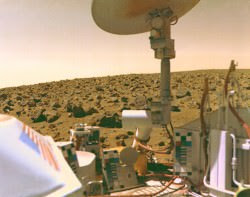


No comments:
Post a Comment